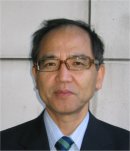|
Plenary
Lecture
Molecular Simulation and Experimental Approaches to
Molecules and Ions Confined in Hydrophobic Solid
Nanospaces for Sustainable Engineering

Professor Katsumi Kaneko
Graduate School of Science
Chiba University, Japan
E-mail:
kaneko@pchem2.s.chiba-u.ac.jp
Abstract:
Nanoporous solids such as activated carbon fiber (ACF),
single wall carbon nanotube(SWCNT), double wall carbon
nanotube(DWCNT), single wall carbon nanohorn(SWCNH), and
metal organic framework (MOF) s have nanoscale spaces
offering the deep interaction potential wells for
molecules and ions, which can be helpful to construct
sustainable technology. In this lecture, unusual
adsorption behaviors for molecules and ions which have
been shown with experimental techniques and molecular
simulation.
Even supercritical gas molecules of H2 and CH4 are
physically adsorbed predominantly in the nanospaces of
ACF, SWCNT, and DWCNT above the bulk critical
temperature, giving their dense states comparable to the
bulk liquid or solid phase.?Typical examples will be
presented. Reactivated ACF shows superior adsorptivity
for supercritical CH4: 190 vol.% at 3.5 MPa and 303 K is
larger than the DOE target value (180 vol.%). The
relationship between supercritical H2 adsorptivity and
nanostructure will be given: DWCNT shows better
adsorptivity than SWCNT and intercalation of C60
enhances the adsorptivity of SWCNT due to increase of
the interstitial nanoporosity. The nanospaces show a
marked quantum molecular sieving effect for H2 and D2,
which are evidenced for SWCNH, SWCNT, and Cu-MOF with
quantum grand canonical Monte Carlo simulation.
Water adsorption in nanogate-donated SWCNH indicates the
new mechanism of cluster-chain-cluster on penetration of
0.4 nm-gate of the SWCNH wall. This mechanism is
supported by molecular dynamics.
The effect of addition of organic electrolytes on the
structure of organic solvent propylene carbonate (PC)
was examined by synchrotron X-ray and reverse Monte
Carlo simulation; addition of the electrolytes promotes
orientation of PC molecules in the slit nanospaces of 1
nm in width.
Brief Biografy of the Speaker:
Katsumi Kaneko is a professor of chemistry (physical
chemistry), Department of Chemistry, Graduate School of
Science, Chiba University. He received Dr. of Science
from University of Tokyo. He developed new
characterization methods for nanoporous materials and
elucidated adsorption states of molecules and ions; he
applied molecular and solid state sciences to adsorption
to establish nanospace molecular science.
He has been an Editor of Adsorption Science and
Technology and currently on the Advisory Board of
several international journals such as Carbon, Journal
Experimental Nanoscience, Adsorption, and the Journal of
Porous Materials, and has been elected to a directorship
of the Chemical Society of Japan, whilst he has
previously been a Chairman of the Division of Colloid
and Interface Chemistry of the Chemical Society of
Japan, and President of the International Adsorption
Society (2005-2008).
His work has been reported in more than 380
international journal papers and more than 40 invited
international conference presentations, and has been
recognized by an award from the Chemical Society of
Japan in 1999 and by the American Carbon Society, who
awarded him the Charles E. Pettinos Award in 2007.
|
